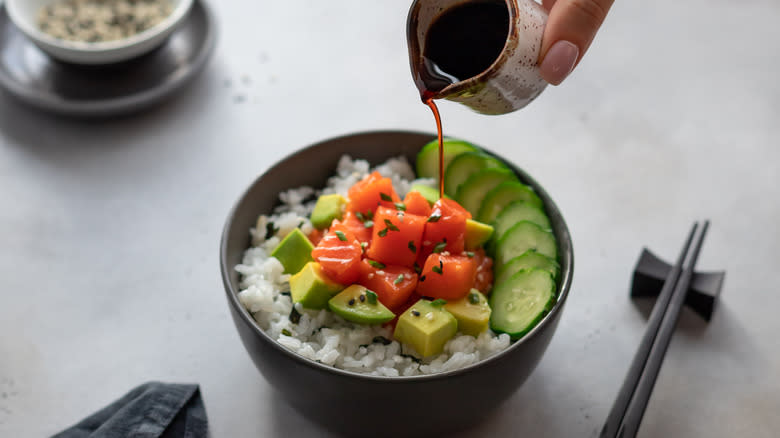The Reason You Should Always Taste Soy Sauce Before Adding It To Poke

What makes a good poke bowl? It's a loaded question with endless answers. The definition of poke has morphed from a simple dish of neatly cubed pieces of marinated fish and rice to bowls that consist of all sorts of tasty additions. Sometimes a base of greens or noodles act as the foundation with proteins ranging from fresh ahi tuna to salmon and beyond. Then come toppings like avocado, edamame, mango, cucumber, pickled ginger, sesame seeds, or a sprinkle of furikake all before sauces give bowls the finishing touch. Despite that you could drizzle on wasabi mayo, eel sauce, or citrusy ponzu, the condiment that remains unmatched is soy sauce — just make sure you give it a taste before pouring.
Predominantly salty, soy sauce can also be quite complex. Teeming with umami, it can have a faint sweetness along with a bitter edge, depending on the variety and even the brand. Given its potential to have such varying nuances, it's wise to make a habit out of tasting soy sauce before using it. This is a good rule of thumb to follow whenever you use the condiment to season dishes, but it's particularly important with poke as raw fish can be pretty delicate. By tasting soy sauce beforehand, you can better gauge its saltiness and overall intensity to understand how the flavor of the fish (and its accompaniments) will be impacted. Of course, it can also spare you from making the mistake of over-seasoning a poke bowl.
Read more: The 20 Best Olive Oils For Cooking
Start With The Right Sauce And Use It To Season Poke Properly

Since there are so many different types of soy sauce, determining which is ideal for seasoning can be overwhelming. Generally speaking, light soy sauces are a safe bet. Unlike darker versions that are thicker and sweeter due to longer fermentation periods, lighter sauces have a brighter and more acidic flavor that's ideal for raw fish. Bear in mind that the variety of fish can play a role in choosing the right soy sauce as fattier fish can withstand a punchier condiment, whereas mild fish might require an equally mild white soy sauce (shiro shoyu).
With a suitable and high quality soy sauce in tow, the next part of the puzzle is knowing how to use it. After giving it a taste, you might be tempted to start drizzling, but don't, unless you're about to enjoy the dish. Because soy sauce can cure fish, it's wise to pour in modest amounts and gently mix ingredients for better dispersion. Doing this will ensure a pleasing contrast of flavors and textures. Taste in between tossing, adjusting the amount of sauce to your liking. Meant as a flavor enhancer, remember that soy sauce is not the main ingredient, so avoid totally saturating the bowl.
The bottom line is this: Let your palate be your guide when saucing poke bowls. Keeping tabs on how flavor progresses is the only way to ensure soy sauce elevates rather than hinders your dish.
Read the original article on Tasting Table.

 Yahoo Lifestyle
Yahoo Lifestyle 
